Make-Ahead Slow Cooker Mashed Potatoes
Make the best mashed potatoes you’ve ever eaten in 30 minutes with this foolproof recipe. As an added bonus, this mashed potato recipe saves time, stress, and oven space!
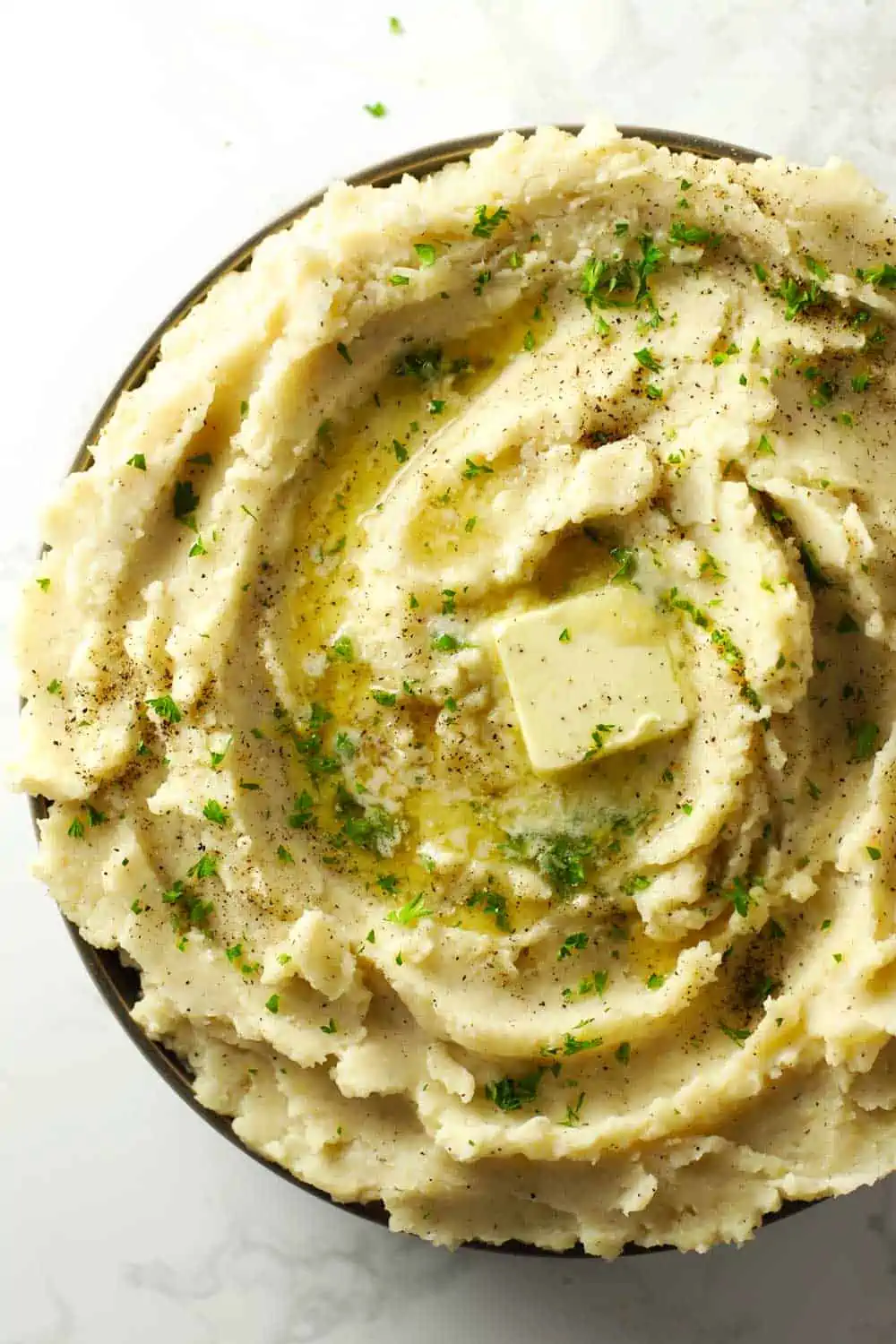
Why this recipe works.
Foolproof Deliciousness: This recipe is foolproof and shows you exactly how to make perfect mashed potatoes every time with simple ingredients.
Expert Tips: This recipes includes a few simple tricks that make potatoes so good, you’ll dream about them.
Make-Ahead: Make this recipe ahead of time so you can spend more time with your loved ones and less time in the kitchen.
Great Holiday or Party Recipe: This is a PERFECT recipe for holidays, potlucks, and dinner parties. It can be made ahead of time, is easy to transport, frees up oven space, and is a CROWD PLEASER!
Amazing Leftovers: The leftovers are just as good, if not better, as when they’re freshly made. Cook once, eat multiple times!
Ingredients You’ll Need
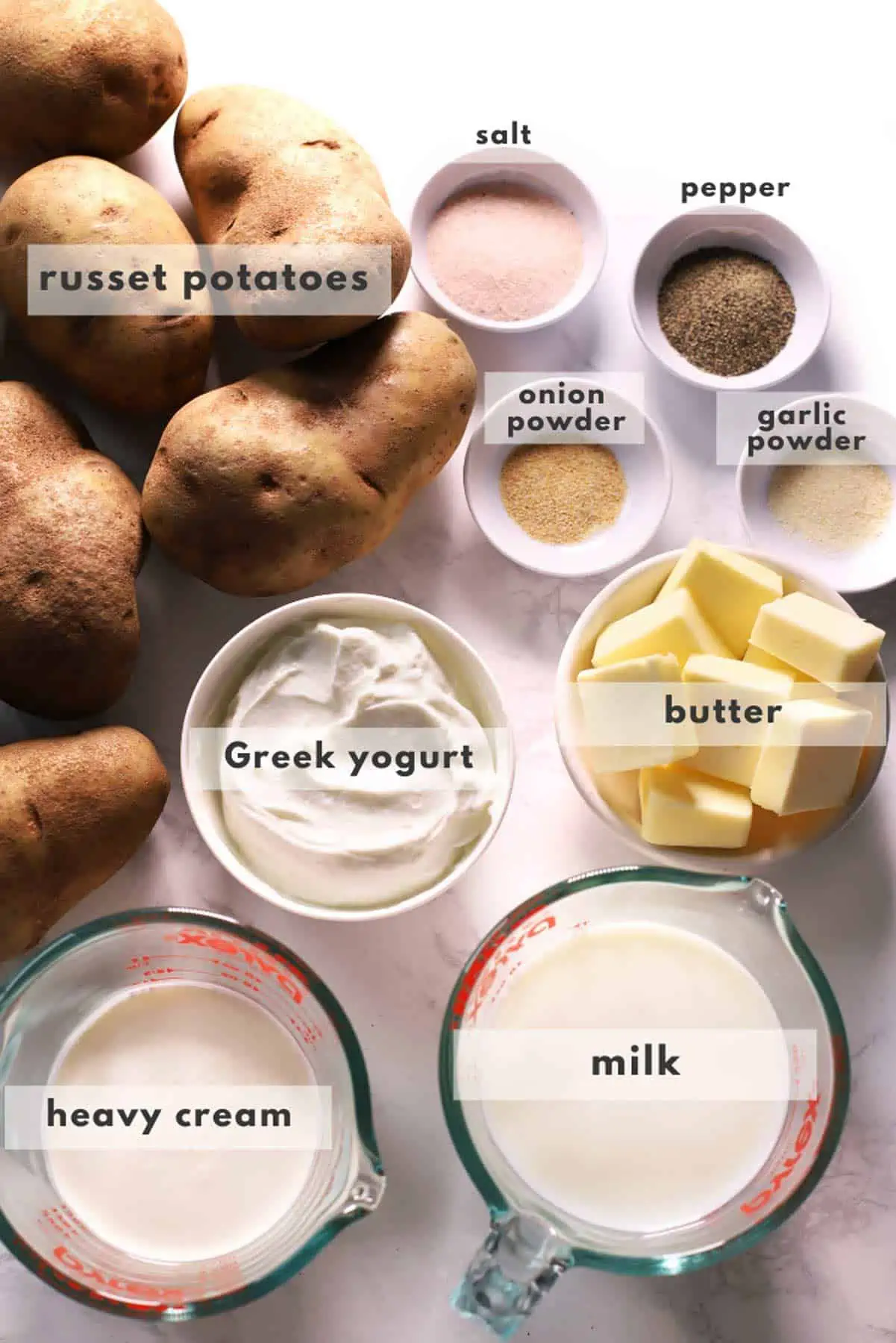
Ingredient Notes
- Russet Potatoes – Russet potatoes or Idaho potatoes are best for creamy, smooth, fluffy potatoes. These varieties can withstand more mashing than others without becoming gummy.
- Greek Yogurt – I recommend using full-fat (or 4%) Greek yogurt but 2% or fat-free varieties work as well. Sour cream can also be used as a substitute in this recipe.
Step-by-Step Instructions
1. Prep Potatoes
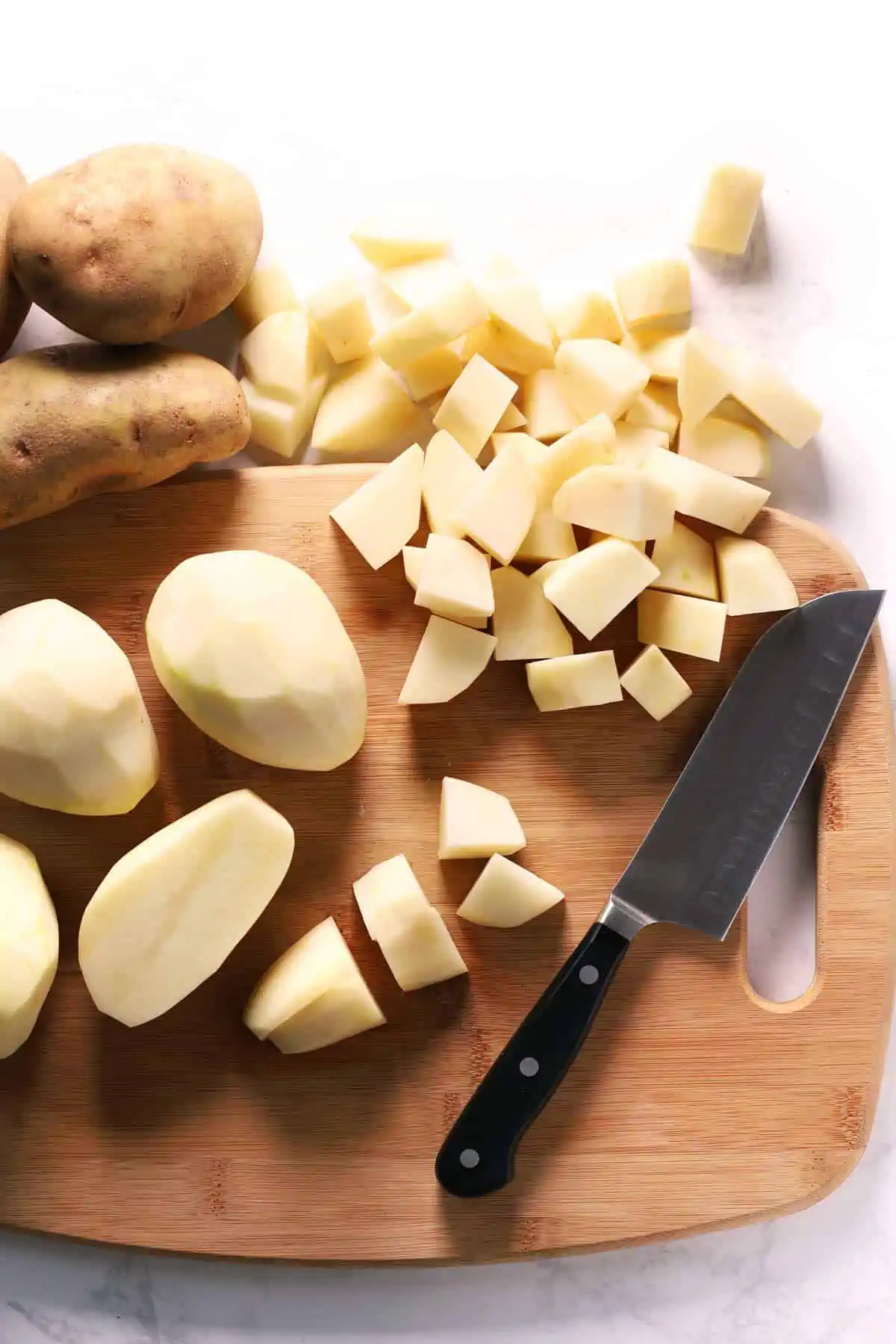
Peel and cut potatoes into 1″ pieces.
2. Boil Potatoes
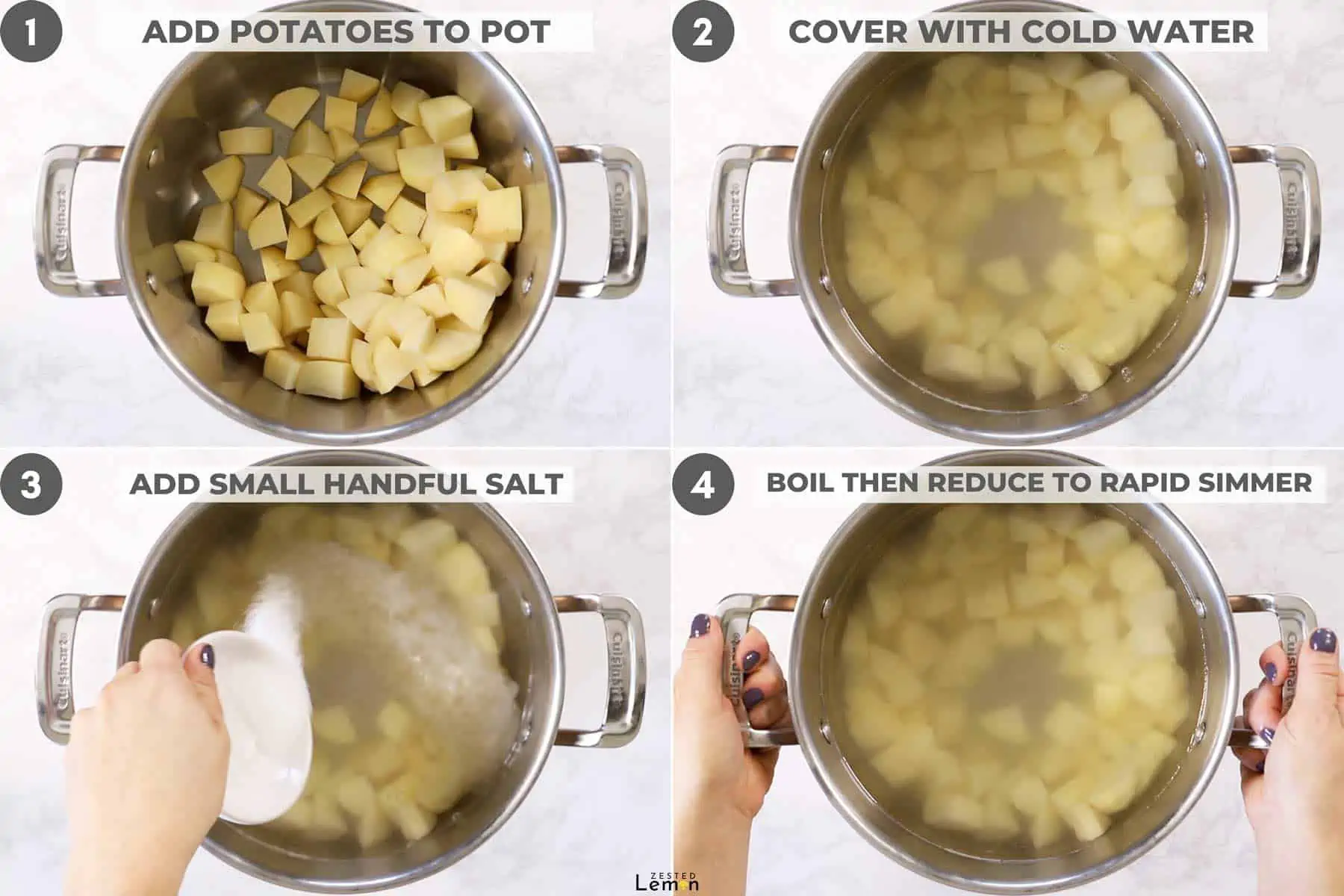
- Cold Water Start – Put the potatoes in a large pot and add enough cold water to cover the potatoes by 1″-2″.
- Salt the water by adding a small handful of salt to the pot. Don’t worry! Most of this salt goes down the drain with the water after the potatoes are done cooking!
- Salting the water enhances the flavor of the potatoes and makes them taste incredible. Trust me on this one!
- Bring to a rolling boil over high heat. A rolling boil is when there are a lot of big rapid bubbles and a lot movement in the water.
- Then reduce to a rapid simmer. A rapid simmer is when there are a lot of smaller bubbles and less movement in the water than a rolling boil.
- Cook until fork tender (usually 15-25 minutes). Then drain them well.
3. Mash Potatoes
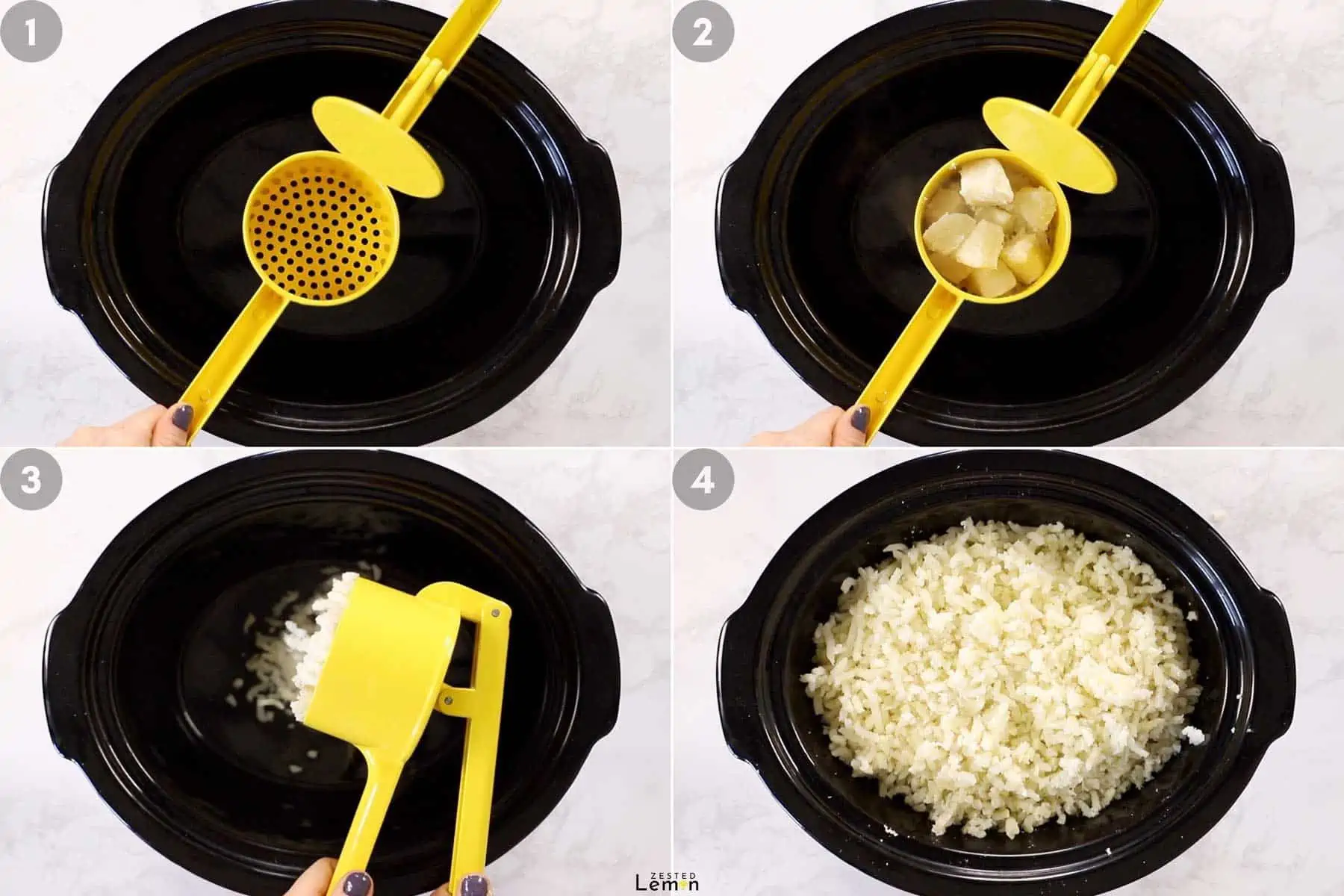
- While the potatoes are still hot, but cool enough to handle, use a stainless steel ricer (recommended and shown above) or potato masher to mash the potatoes.
- If using a potato masher, do not over-mash the potatoes. Too much mashing will make the potatoes gooey and gummy. Mash the potatoes until they are creamy with a slightly chunky texture but no more!
- TIP: Mash the potatoes right in the slow cooker to save on dishes!
4. Mix Ingredients Together
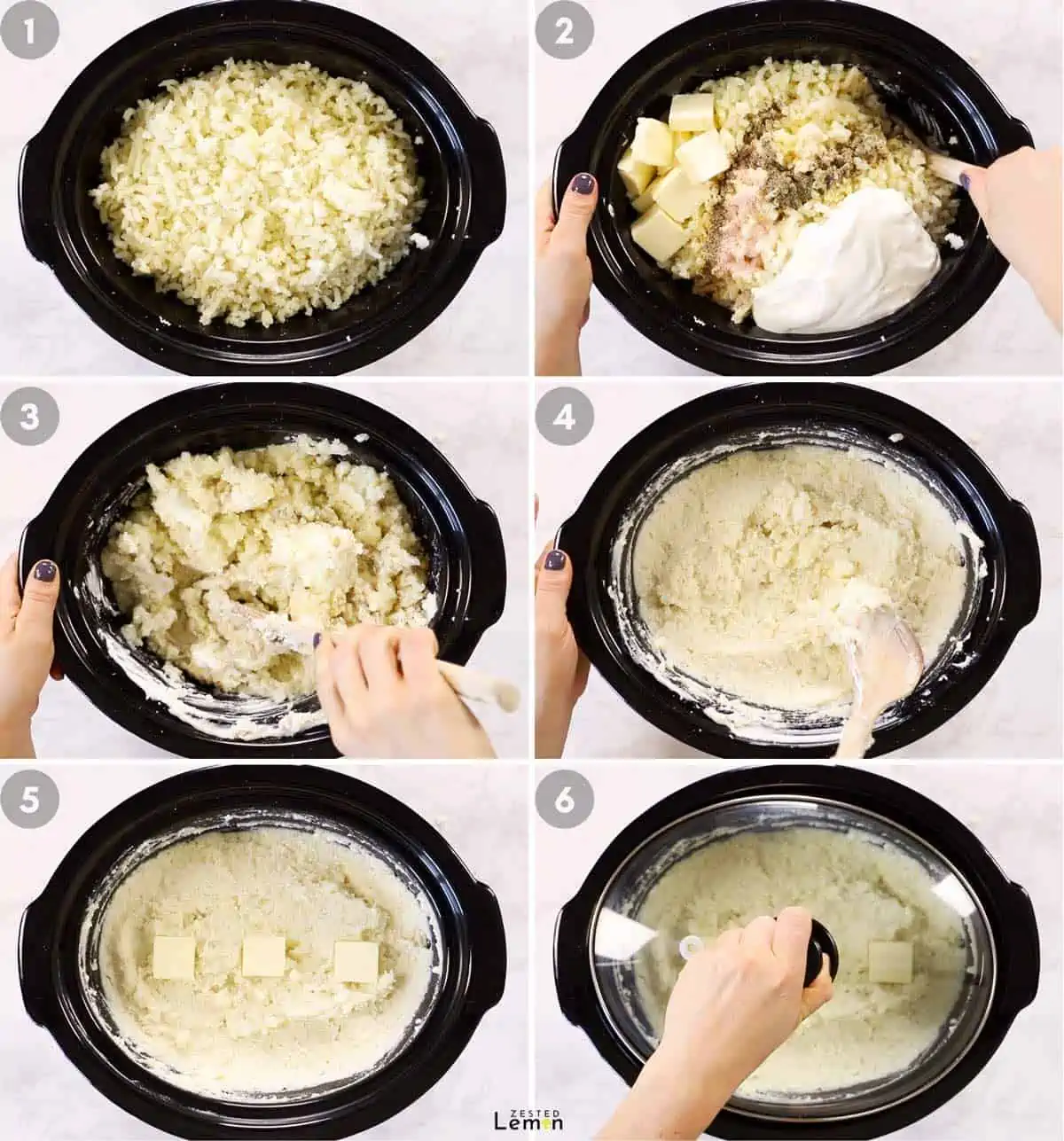
- Mix Ingredients: Add all remaining ingredients except 2 Tbsp. butter to the potatoes and stir until combined.
- Top With Slices of Butter: Cut the last 2 Tbsp. of butter into pieces and put on top of potatoes. Cover with the slow cooker lid.
- If serving potatoes within a few hours, put the slow cooker on warm and stir occasionally. Serve and enjoy!
- If making potatoes ahead of time, refrigerate potatoes until needed. About 3 hours before serving, take the potatoes out of the fridge and put the slow cooker on low, stirring occasionally. Serve and enjoy!
Top 5 Expert Tips For Perfect Mashed Potatoes
- Use russet potatoes.
- Do a cold water start. This means put the potatoes in a large pot, cover with cold water, add a small handful of salt, and then put on the stove.
- Salt the water. Don’t be shy. Throw in a small handful. Cooking them in salted water adds remarkably good flavor.
- Don’t worry! Most of the salt with go down the drain when you drain the potatoes.
- Use a ricer to mash. It is foolproof and the best tool for perfectly smooth and fluffy mashed potatoes every time with minimal effort.
- Mash while hot. Mashing your taters while hot will make the lightest/fluffiest potatoes.
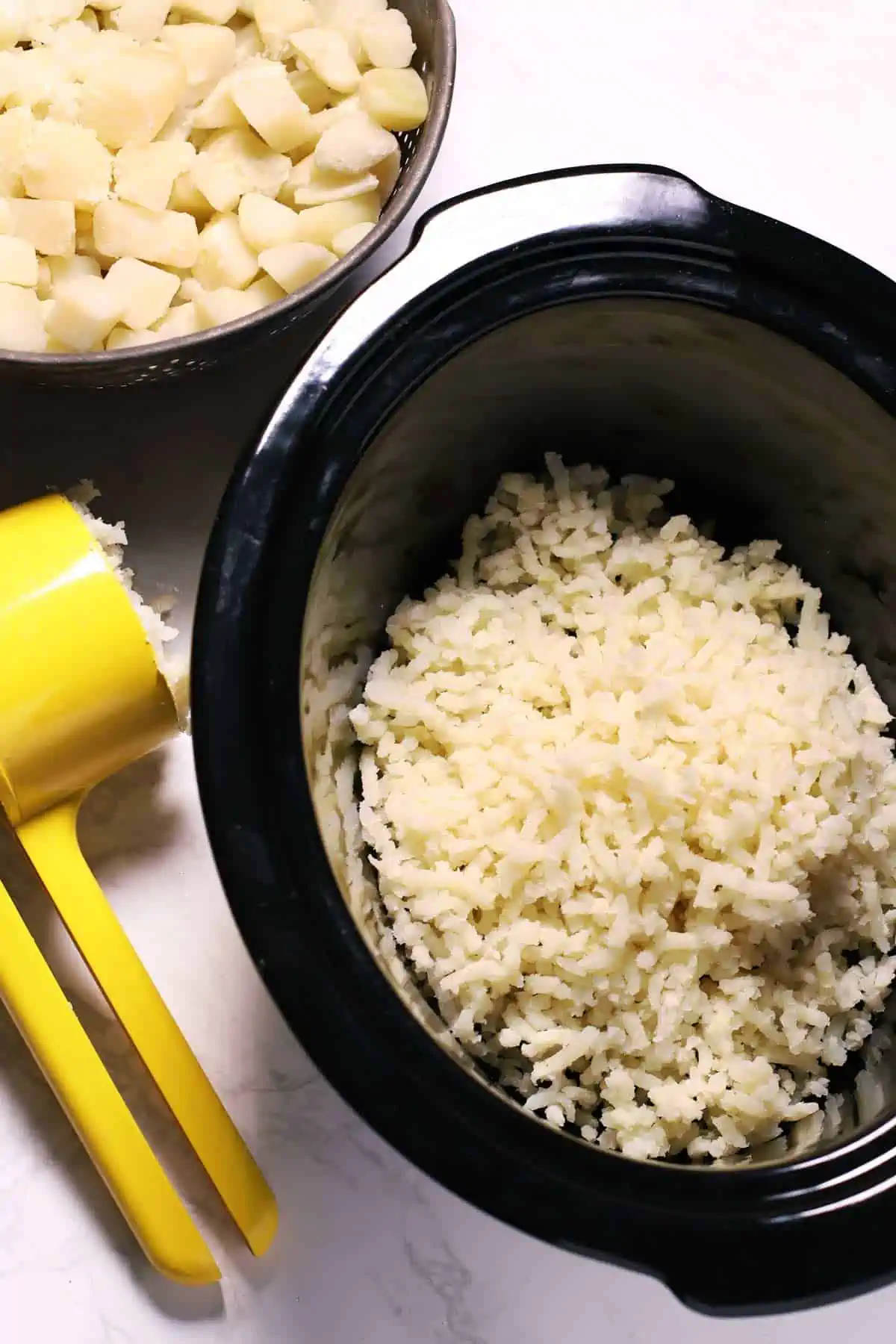
Mashed Potato FAQs
Can you make mashed potatoes ahead of time?
Yes! You can make these taters a day or two ahead of time and pop them in the fridge until needed.
Then a few hours before showtime, put the mashed potatoes in a slow cooker on low with a couple pats of butter. Stir occasionally and viola! Amazing mashed potatoes!
How many pounds of potatoes per person?
Plan for 1/2 lb. of potatoes per person. However, if you’re feeding serious mashed potato lovers, I recommend making a double batch just to be safe. These potatoes makes excellent leftovers and reheat wonderfully!
Note: 1 lb. of potatoes makes about 2 cups of mashed potatoes.
How long do you boil potatoes for mashed potatoes?
Usually anywhere from 15-25 minutes. However, potato size, pot size, and heat source impact cook time.
Personally, I rarely focus on cook time when boiling potatoes. Instead I rely on the fork test, visual test, and taste test!
The Fork Test
Potatoes are done when a fork can easily pierce the potato with no resistance and the potatoes easily break apart when pierced. If there is any resistance, continue cooking.
Tip: Do not use a knife to test doneness. A sharp knife can be deceiving when determining if potatoes are done cooking.
The Visual Test
Potatoes are done when they look like the image below. The edges should look a little crumbly.
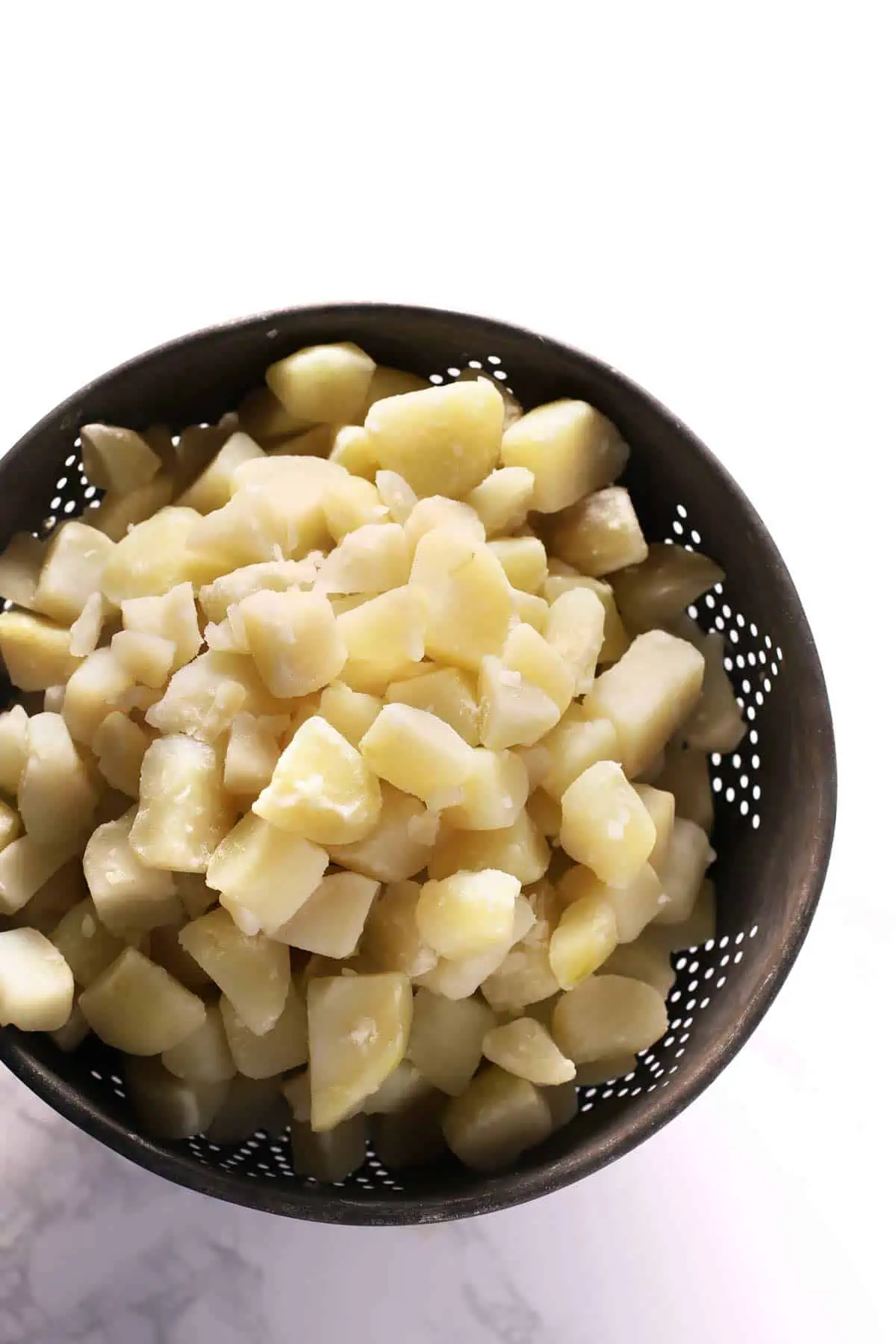
The Taste Test
Another way to check doneness is to just try a piece of potato. Done potatoes should have a soft, smooth, and overall appealing texture. Underdone potatoes tend to have grainy, lumpy, unappetizing textures.
How to avoid gummy mash potatoes?
The method in which you mash your potatoes can either make or break your mashed taters. Here’s why.
Potatoes release starch when mashed. More mashing = more starches released. Too many released starches result in mashed potatoes that have the consistency of glue. Not great.
The more you mash, the heavier and gummier the potatoes. The less you mash, the lighter and fluffier the potatoes.
Many kitchen tools can be used to mash potatoes. Below are my recommendations from best to worst.
- Ricer – A ricer makes perfectly smooth mashed potatoes with the least amount of effort. Tip: Stainless steal ricers work significantly better than plastic ones. This is my favorite ricer.
- Food Mill – A food mill also produces perfectly smooth mashed potatoes with minimal effort. The downsides are it is harder to clean and takes up more storage space.
- Colander – Don’t have a ricer or food mill? Just use a colander! Put the potatoes in a colander. Then put the colander in a large bowl. Use a spatula to push the potatoes through the holes in the colander (same concept as a ricer). Once through the colander, the potatoes will fall into the large bowl. This method does take more time and a significant amount of arm strength but is a good option if you don’t want to buy another kitchen tool.
- Potato Masher – Cheap, easy to use, quick to clean and takes up minimal storage space. The texture will be slightly chunky, but still creamy. Just be mindful to not over-mash your taters.
- Hand or Stand Mixers – Mixers create heavy dense mashed potatoes. However, they can turn your potatoes to glue VERY quickly and I don’t recommend them. Use mixers with extreme caution.
- Blenders and Food Processors – I recommend avoiding these tools altogether. They will create a gummy mashed potato disaster!
Common Mistakes and How to Fix Them
How to fix mashed potatoes that are too salty.
To counteract saltiness, add something with an acidic flavor. Sour cream and plain Greek yogurt are good options for mashed potatoes. A little lemon juice will also do the trick!
You can also dilute the saltiness by mixing in more milk, cream or unseasoned potatoes.
How to fix runny mashed potatoes.
Option 1 – Put the runny potatoes in a large pan over low to medium/low heat. Do not cover. The heat will evaporate some of the excess moisture and thicken the potatoes. Stir the potatoes occasionally to keep them from sticking to the bottom of the pan.
Option 2 – Thicken runny potatoes by stirring in cornstarch or flour. Start with a half tablespoon and add more as needed.
How to fix dry mashed potatoes.
Mix in more moisture such as milk, half and half, or heavy cream. You could also throw in some sour cream, Greek yogurt, cream cheese or butter for added creamy richness.
How to fix gluey mashed potatoes.
Gluey and gummy mashed potatoes are the result of over-mashing.
The easiest course of action is to avoid gluey potatoes altogether because there isn’t a way to truly fix gluey mashed potatoes.
However, if you find yourself stuck with a pot of gummy potatoes, below are a few ideas to try to salvage them.
- Make a batch of instant mashed potatoes and stir them into the gluey ones.
- Turn it into a casserole. Combine the gluey potatoes with ingredients such as cut up veggies, chicken, breadcrumbs, butter and parmesan cheese. Put the mixture in a casserole dish, top with cheese and/or breadcrumbs and pop it in the oven.
- Throw the gluey potatoes in the trash. Get a ricer and make perfect mashed potatoes every time.
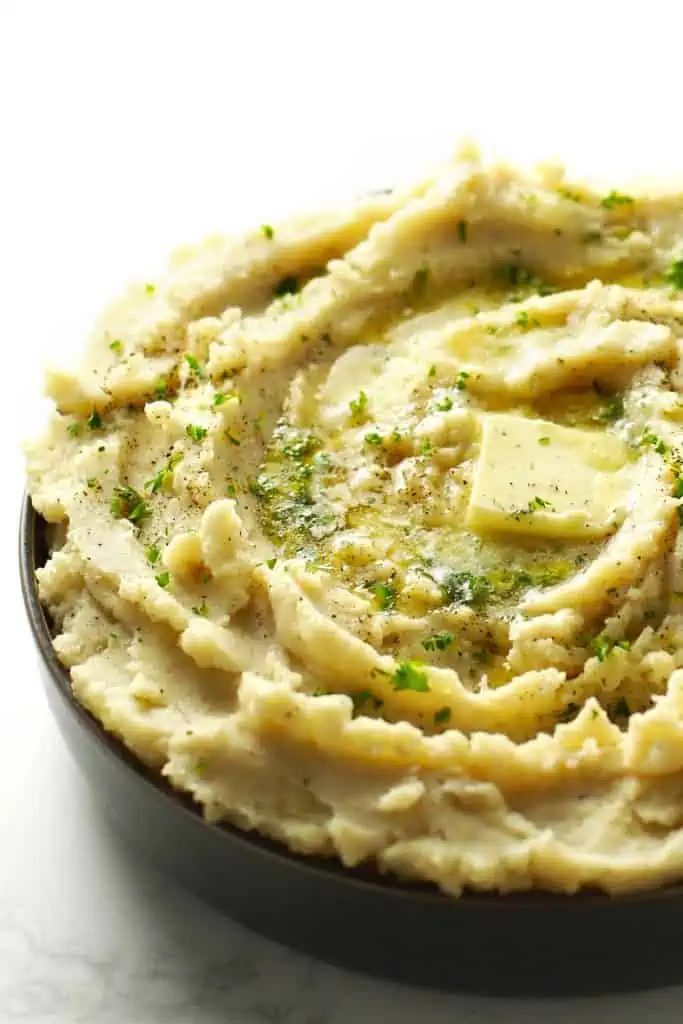
Other Potato Recipes
I picked out a few other potato recipes you might like!
All are great options but nothing beats a big scoop of creamy mashed potatoes smothered in gravy.
Watch the How-to Video
Hungry for more tasty eats? Follow me on Instagram and Pinterest and subscribe to my email list for Zested Lemon’s latest recipes and updates.
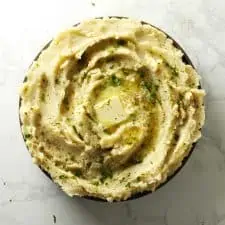
Make-Ahead Slow Cooker Mashed Potatoes
Ingredients
- 5 lbs. russet potatoes
- 1/2 cup butter + 2 Tbsp.
- 1/2 cup heavy whipping cream
- 1 cup plain Greek yogurt
- 1 cup milk
- 1/4 tsp. onion powder
- 1/4 tsp. garlic powder
- 1 1/2 tsp. salt
- 1 tsp. pepper
Instructions
Prep Potatoes
- Peel potatoes and cut into 1" cubes.
Boil Potatoes
- Add the potatoes to a large pot and add enough cold water to cover the potatoes by 1"-2". This is called a "cold water start".
- Add a small handful of salt to the pot. Do not skip this step (Note 1)!
- Put the pot over high heat until it comes to a rolling boil (Note 2). Then reduce the heat to medium – medium/high or until the water comes to a rapid simmer (Note 3).
- Cook until the potatoes are fork tender which usually takes around 15-25 minutes (Note 4). Then drain the potatoes thoroughly.
Mash & Mix Potatoes
- While the potatoes are still hot, but cool enough to handle, use a stainless steel ricer (recommended and shown above) or potato masher to mash the potatoes directly in the slow cooker (Note 5).
- Add all remaining ingredients except 2 Tbsp. butter to the slow cooker. Using a wooden spoon, stir until just combined.
- Cut the last 2 Tbsp. of butter into pieces. Put the pieces of butter on top of the potatoes and cover with the slow cooker lid.
Final Step – If serving potatoes within a few hours
- If serving potatoes within a few hours, put the slow cooker on warm and stir occasionally (Note 6).
Final Step – If making potatoes ahead of time
- If making potatoes ahead of time, put potatoes in refrigerator. About 3 hours before serving, take the potatoes out of the fridge and let them sit at room temperature for 30 minutes. Then put the slow cooker on low for 3 hours, stirring occasionally (Note 6, 7, 8).
Notes
- Salting the water enhances the flavor of the potatoes and makes them taste incredible. Trust me on this one! Also, no need to worry about consuming too much salt because most of the salt goes down the drain with the water after the potatoes are done cooking!
- A rolling boil is when there are a lot of big rapid bubbles and a lot movement in the water.
- A rapid simmer is when there are a lot of smaller bubbles and less movement in the water than a rolling boil.
- Potatoes are done when a fork can easily pierce the potato with no resistance and the potatoes easily break apart when pierced. When drained, the edges of the potatoes should look a tiny crumbly (see image above in post).
- Do not over-mash potatoes or else your potatoes will become gooey and gummy. The best way to avoid this problem is to use a stainless steel ricer if you have one. It is the quickest and easiest way to ensure the fluffiest smoothest potatoes with the least amount of effort. The next best option is to use a potato masher (with care!) and stop mashing as soon as the potatoes are mashed. I do NOT recommend using an electric mixer, blender, or food processor.
- If the potatoes get too dry while in the slow cooker, add a splash of milk and/or a couple tablespoons of butter.
- If short on time, put the slow cooker on high for 1.5 hours, stirring frequently, to heat the potatoes quickly after refrigeration.
- If really short on time, microwave the uncovered potatoes, for 45 second intervals, to heat the potatoes very quickly after refrigeration. Continue intervals while stirring between until the potatoes are warmed through. Then keep warm in the slow cooker while serving.

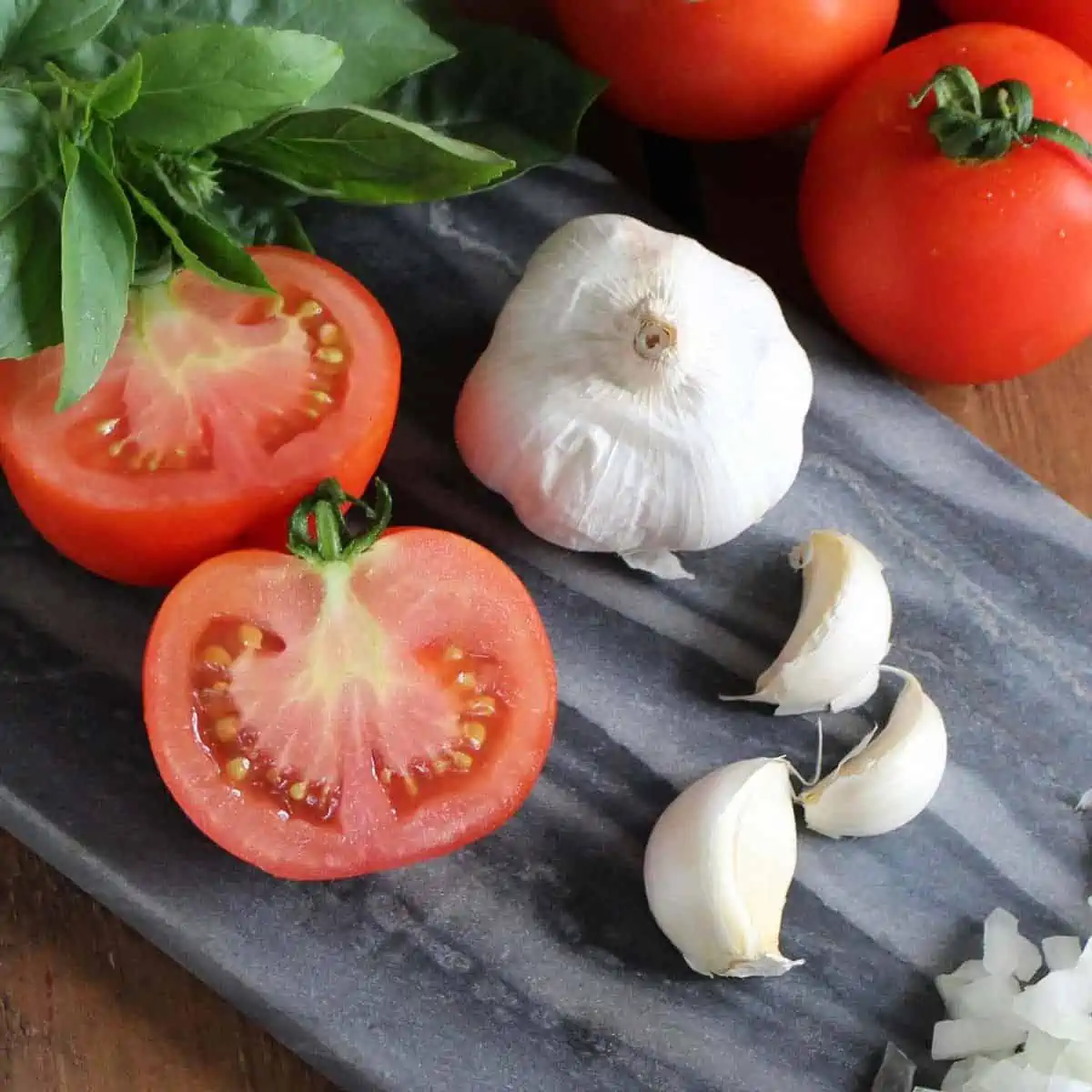
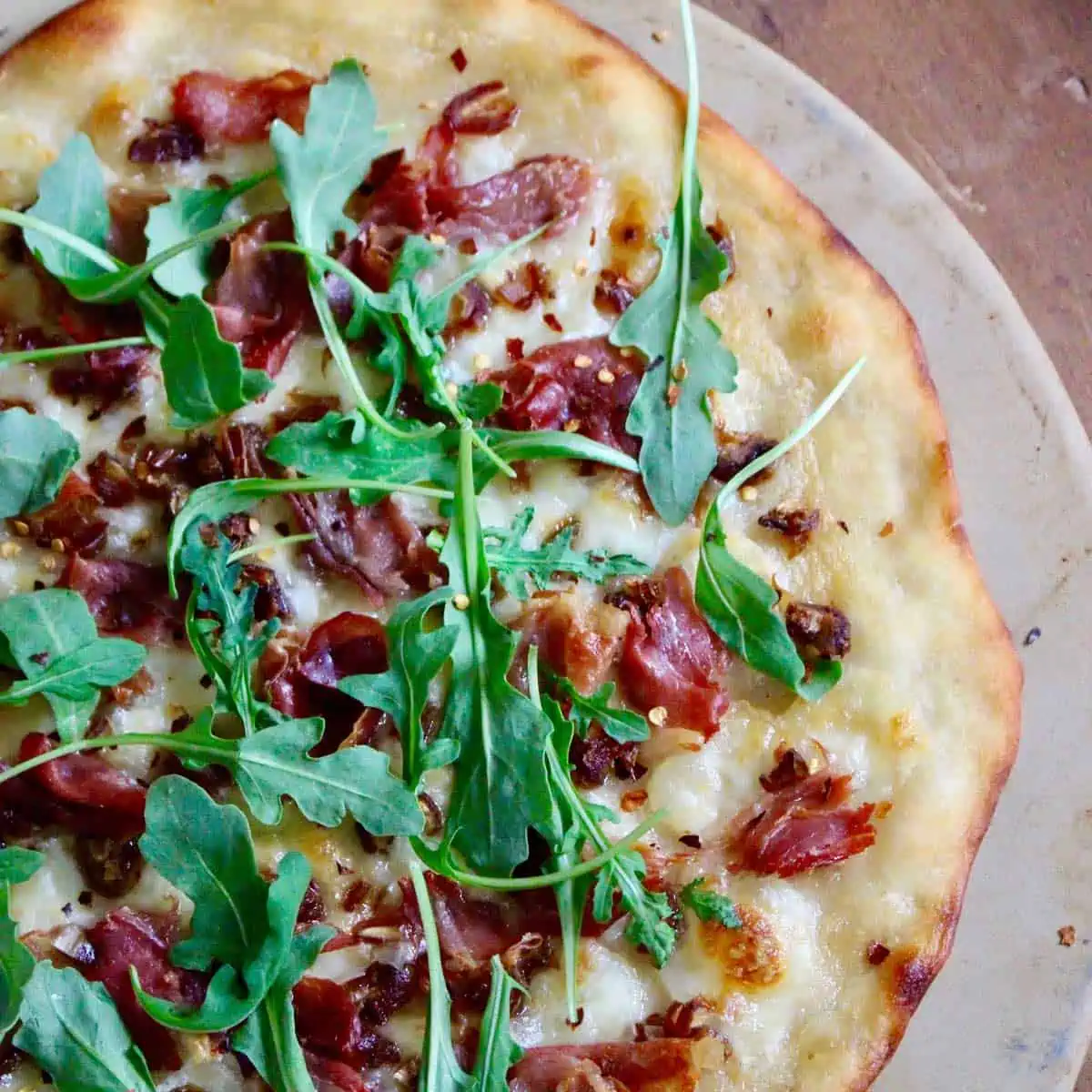



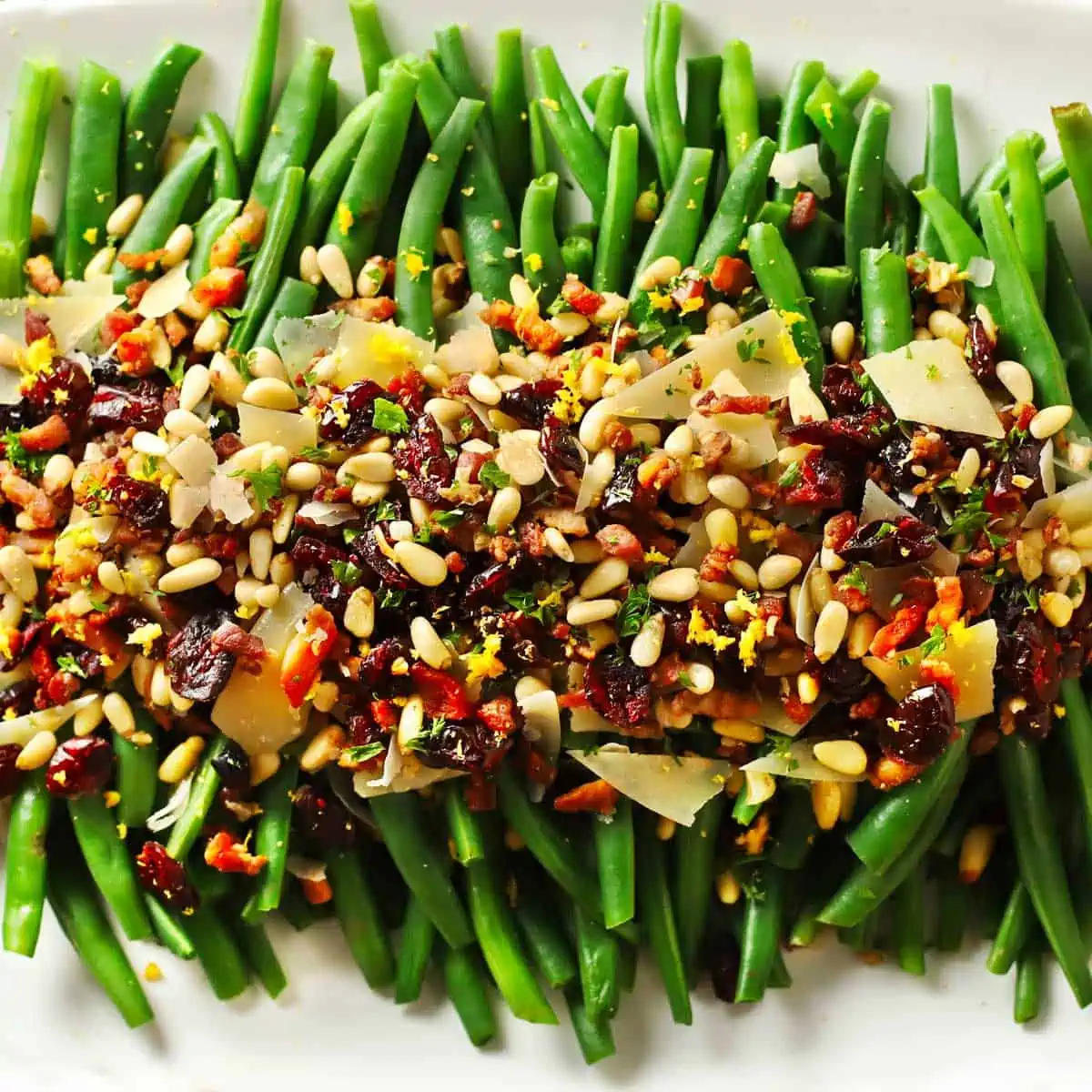
So good!
Thanks ST!
Holy Grail! This is my new go-to dish. It is so simple and only a couple of ingredients! I made them for a Thanksgiving and they were a total hit. Yummm!
Glad to hear! I love anything make-ahead!